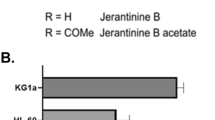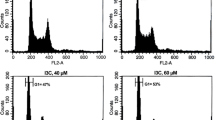Abstract
Purpose
Exposure to carboplatin (CBDCA) has been demonstrated to result in apoptotic and/or necrotic cell death, but molecular mechanisms underlying CBDCA-induced apoptosis or necrosis remain largely unclear. Here, we examined whether activation of c-Jun NH2-terminal kinase (JNK) modulates the mode of cell death induced by CBDCA in CD31 B lymphoma cells.
Methods
The mode of cell death (apoptosis versus necrosis) was investigated by flow cytometry using 7-amino-actinomycin D (7-AAD) and annexin-FITC probes. To evaluate the role of JNK1 in CBDCA-induced cell death, CH31 B lymphoma cells overexpressing dominant-negative form of JNK1 (dnJNK1) or constitutively active form of JNK1 (MKK7-JNK1) were established. Intracellular accumulation of superoxide anion (O2 −) was determined by flow cytometry using the fluorescent probe dihydroethidium (DHE).
Results
The CBDCA-induced primary apoptosis and secondary necrosis were abrogated in the dnJNK1-overexpressing CH31 cells, while it was somewhat enhanced in the MKK7-JNK1-overexpressing cells. In contrast, the CBDCA-induced primary necrosis was reduced by MKK7-JNK1, with a concurrent decrease in production of O2 −. The superoxide anion scavenger for butylated hydroxyanisol (BHA) partially reduced the CBDCA-induced O2 − production and necrotic, but not apoptotic, death in both wild type and dnJNK1-overexpressing CH31 cells.
Conclusions
Prolonged activation of JNK1 appears to be involved in CBDCA-induced apoptosis with prevention of necrosis induction, and the induction of necrosis appears to correlate with CBDCA-induced O2 − production, which is partially blocked by co-culture with BHA. These observations provide valuable information for understanding molecular mechanisms underlying CBDCA-induced cell death, and hopefully for the design of novel treatment modalities for patients with tumors.






Similar content being viewed by others
Abbreviations
- CBDCA:
-
Carboplatin
- JNK:
-
c-Jun NH2-terminal kinase
- MAPK:
-
Mitogen-activated protein kinase
- ROS:
-
Reactive oxygen species
- dnJNK:
-
Dominant-negative JNK
- BHA:
-
Butylated hydroxyanisol
- MKK:
-
MAPK kinase
- 7-AAD:
-
7-Amino-actinomycin D
- DHE:
-
Dihydroethidium
References
Zamboglou N, Schnabel T, Kolotas C, Achterrath W, Strehl H, Dalhauser S, Vogt HG, Lenaz L, Schmitt G (1994) Carboplatin and radiotherapy in the treatment of head and neck cancer: six years’ experience. Semin Oncol 21:45–53
Niitani H, Kobayashi K (1992) Cisplatin/carboplatin therapy in non-small cell lung cancer. Oncology 49(Suppl 1):51–56
Mey UJ, Olivieri A, Orlopp KS, Rabe C, Strehl JW, Gorschlueter M, Hensel M, Flieger D, Glasmacher AG, Schmidt-Wolf IG (2006) DHAP in combination with rituximab vs DHAP alone as salvage treatment for patients with relapsed or refractory diffuse large B-cell lymphoma: a matched-pair analysis. Leuk Lymphoma 47:2558–2566
Rabik CA, Dolan ME (2007) Molecular mechanisms of resistance and toxicity associated with platinating agents. Cancer Treat Rev 33:9–23
Wernyj RP, Morin PJ (2004) Molecular mechanisms of platinum resistance: still searching for the Achilles’ heel. Drug Resist Updat 7:227–232
Reed JC, Kroemer G (2000) Mechanisms of mitochondrial membrane permeabilization. Cell Death Differ 7:1145
Susin SA, Zamzami N, Kroemer G (1998) Mitochondria as regulators of apoptosis: doubt no more. Biochim Biophys Acta 1366:151–165
Shibuya H, Kato Y, Saito M, Isobe T, Tsuboi R, Koga M, Toyota H, Mizuguchi J (2003) Induction of apoptosis and/or necrosis following exposure to antitumour agents in a melanoma cell line, probably through modulation of Bcl-2 family proteins. Melanoma Res 13:457–464
Ferrer M, Izeboud T, Ferreira CG, Span SW, Giaccone G, Kruyt FA (2003) Cisplatin triggers apoptotic or nonapoptotic cell death in Fanconi anemia lymphoblasts in a concentration-dependent manner. Exp Cell Res 286:381–395
Herault O, Colombat P, Domenech J, Degenne M, Bremond JL, Sensebe L, Bernard MC, Binet C (1999) A rapid single-laser flow cytometric method for discrimination of early apoptotic cells in a heterogenous cell population. Br J Haematol 104:530–537
Searle J, Kerr JF, Bishop CJ (1982) Necrosis and apoptosis: distinct modes of cell death with fundamentally different significance. Pathol Annu 17 Pt 2:229–259
Zanke BW, Boudreau K, Rubie E, Winnett E, Tibbles LA, Zon L, Kyriakis J, Liu FF, Woodgett JR (1996) The stress-activated protein kinase pathway mediates cell death following injury induced by cis-platinum, UV irradiation or heat. Curr Biol 6:606–613
Xia Z, Dickens M, Raingeaud J, Davis RJ, Greenberg ME (1995) Opposing effects of ERK and JNK-p38 MAP kinases on apoptosis. Science 270:1326–1331
Takada E, Shimo K, Hata K, Abiake M, Mukai Y, Moriyama M, Heasley L, Mizuguchi J (2005) Interferon-β-induced activation of c-Jun NH2-terminal kinase mediates apoptosis through up-regulation of CD95 in CH31 B lymphoma cells. Exp Cell Res 304:518–530
Takada E, Toyota H, Suzuki J, Mizuguchi J (2001) Prevention of anti-IgM-induced apoptosis accompanying G1 arrest in B lymphoma cells overexpressing dominant-negative mutant form of c-Jun NH2-terminal kinase 1. J Immunol 166:1641–1649
Koyama T, Mikami T, Imakiire A, Yamamoto K, Toyota H, Mizuguchi J (2006) Apoptosis induced by chemotherapeutic agents involves c-Jun NH2-terminal kinase activation in sarcoma cell lines. J Orthop Res 24:1153–1162
Mikami T, Koyama T, Imakiire A, Yamamoto K, Furuhata M, Toyota H, Mizuguchi J (2006) c-Jun NH2-terminal kinase activation is required for apoptotic cell death induced by TNF-related apoptosis-inducing ligand plus DNA-damaging agents in sarcoma cell lines. Anticancer Res 26:1153–1160
Tsuruta F, Sunayama J, Mori Y, Hattori S, Shimizu S, Tsujimoto Y, Yoshioka K, Masuyama N, Gotoh Y (2004) JNK promotes Bax translocation to mitochondria through phosphorylation of 14-3-3 proteins. EMBO J 23:1889–1899
Lei K, Davis RJ (2003) JNK phosphorylation of Bim-related members of the Bcl2 family induces Bax-dependent apoptosis. Proc Natl Acad Sci USA 100:2432–2437
Strasser A (2005) The role of BH3-only proteins in the immune system. Nat Rev Immunol 5:189–200
Jacobson MD (1996) Reactive oxygen species and programmed cell death. Trends Biochem Sci 21:83–86
Shen HM, Liu ZG (2006) JNK signaling pathway is a key modulator in cell death mediated by reactive oxygen and nitrogen species. Free Radic Biol Med 40:928–939
Saitoh M, Nishitoh H, Fujii M, Takeda K, Tobiume K, Sawada Y, Kawabata M, Miyazono K, Ichijo H (1998) Mammalian thioredoxin is a direct inhibitor of apoptosis signal-regulating kinase (ASK) 1. EMBO J 17:2596–2606
Gotoh Y, Cooper JA (1998) Reactive oxygen species- and dimerization-induced activation of apoptosis signal-regulating kinase 1 in tumor necrosis factor-alpha signal transduction. J Biol Chem 273:17477–17482
Kamata H, Honda S, Maeda S, Chang L, Hirata H, Karin M (2005) Reactive oxygen species promote TNFα-induced death and sustained JNK activation by inhibiting MAP kinase phosphatases. Cell 120:649–661
Kim R, Emi M, Tanabe K, Murakami S, Uchida Y, Arihiro K (2006) Regulation and interplay of apoptotic and non-apoptotic cell death. J Pathol 208:319–326
Ventura JJ, Cogswell P, Flavell RA, Baldwin AS, Jr Davis RJ (2004) JNK potentiates TNF-stimulated necrosis by increasing the production of cytotoxic reactive oxygen species. Genes Dev 18:2905–2915
Papa S, Bubici C, Zazzeroni F, Pham CG, Kuntzen C, Knabb JR, Dean K, Franzoso G (2006) The NF-κB-mediated control of the JNK cascade in the antagonism of programmed cell death in health and disease. Cell Death Differ 13:712–729
Fiers W, Beyaert R, Declercq W, Vandenabeele P (1999) More than one way to die: apoptosis, necrosis and reactive oxygen damage. Oncogene 18:7719–7730
Fink SL, Cookson BT (2005) Apoptosis, pyroptosis, and necrosis: mechanistic description of dead and dying eukaryotic cells. Infect Immun 73:1907–1916
Koopman G, Reutelingsperger CP, Kuijten GA, Keehnen RM, Pals ST, van Oers MH (1994) Annexin V for flow cytometric detection of phosphatidylserine expression on B cells undergoing apoptosis. Blood 84:1415–1420
Davis RJ (2000) Signal transduction by the JNK group of MAP kinases. Cell 103:239–252
Orrenius S, Gogvadze V, Zhivotovsky B (2007) Mitochondrial oxidative stress: implications for cell death. Annu Rev Pharmacol Toxicol 47:143–183
Vercammen D, Brouckaert G, Denecker G, Van de Craen M, Declercq W, Fiers W, Vandenabeele P (1998) Dual signaling of the Fas receptor: initiation of both apoptotic and necrotic cell death pathways. J Exp Med 188:919–930
Troyano A, Fernandez C, Sancho P, de Blas E, Aller P (2001) Effect of glutathione depletion on antitumor drug toxicity (apoptosis and necrosis) in U-937 human promonocytic cells. the role of intracellular oxidation. J Biol Chem 276:47107–47115
Gonzalez VM, Fuertes MA, Alonso C, Perez JM (2001) Is cisplatin-induced cell death always produced by apoptosis? Mol Pharmacol 59:657–663
Leist M, Single B, Castoldi AF, Kuhnle S, Nicotera P (1997) Intracellular adenosine triphosphate (ATP) concentration: a switch in the decision between apoptosis and necrosis. J Exp Med 185:1481–1486
Krysko DV, D’Herde K, Vandenabeele P (2006) Clearance of apoptotic and necrotic cells and its immunological consequences. Apoptosis 11:1709–1726
Lopez-Sanchez N, Rodriguez JR, Frade JM (2007) Mitochondrial c-Jun NH2-terminal kinase prevents the accumulation of reactive oxygen species and reduces necrotic damage in neural tumor cells that lack trophic support. Mol Cancer Res 5:47–60
Shen HM, Lin Y, Choksi S, Tran J, Jin T, Chang L, Karin M, Zhang J, Liu ZG (2004) Essential roles of receptor-interacting protein and TRAF2 in oxidative stress-induced cell death. Mol Cell Biol 24:5914–5922
Kaminski M, Niemczyk E, Masaoka M, Karbowski M, Hallmann A, Kedzior J, Majczak A, Knap D, Nishizawa Y, Usukura J, Wozniak M, Klimek J, Wakabayashi T (2004) The switch mechanism of the cell death mode from apoptosis to necrosis in menadione-treated human osteosarcoma cell line 143B cells. Microsc Res Tech 64:255–258
Zhang XD, Wu JJ, Gillespie S, Borrow J, Hersey P (2006) Human melanoma cells selected for resistance to apoptosis by prolonged exposure to tumor necrosis factor-related apoptosis-inducing ligand are more vulnerable to necrotic cell death induced by cisplatin. Clin Cancer Res 12:1355–1364
Acknowledgments
This work was supported by a grant from the Intractable Immune System Disease Research Center of Tokyo Medical University, which is supported by the Ministry of Education, Culture, Sports, Science, and Technology of Japan. We thank Dr. Lynn Heasley (Department of Medicine, University of Colorado Health Sciences Center, Denver, CO) for providing MKK7-JNK1.
Author information
Authors and Affiliations
Corresponding author
Electronic supplementary material
Below is the link to the electronic supplementary material.
Rights and permissions
About this article
Cite this article
Takada, E., Hata, K. & Mizuguchi, J. c-Jun-NH2-terminal kinase potentiates apoptotic cell death in response to carboplatin in B lymphoma cells. Cancer Chemother Pharmacol 62, 569–576 (2008). https://doi.org/10.1007/s00280-007-0638-x
Received:
Accepted:
Published:
Issue Date:
DOI: https://doi.org/10.1007/s00280-007-0638-x




